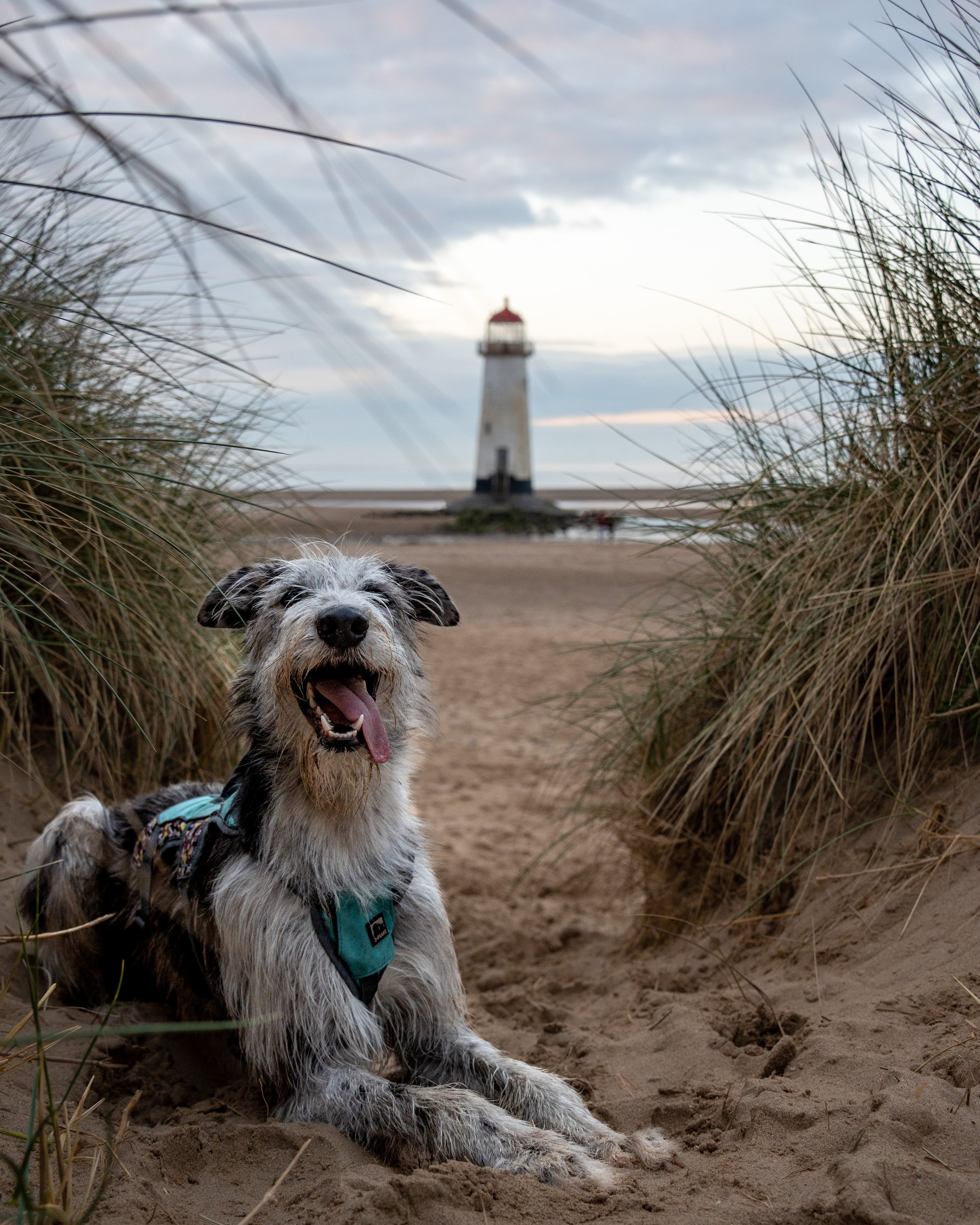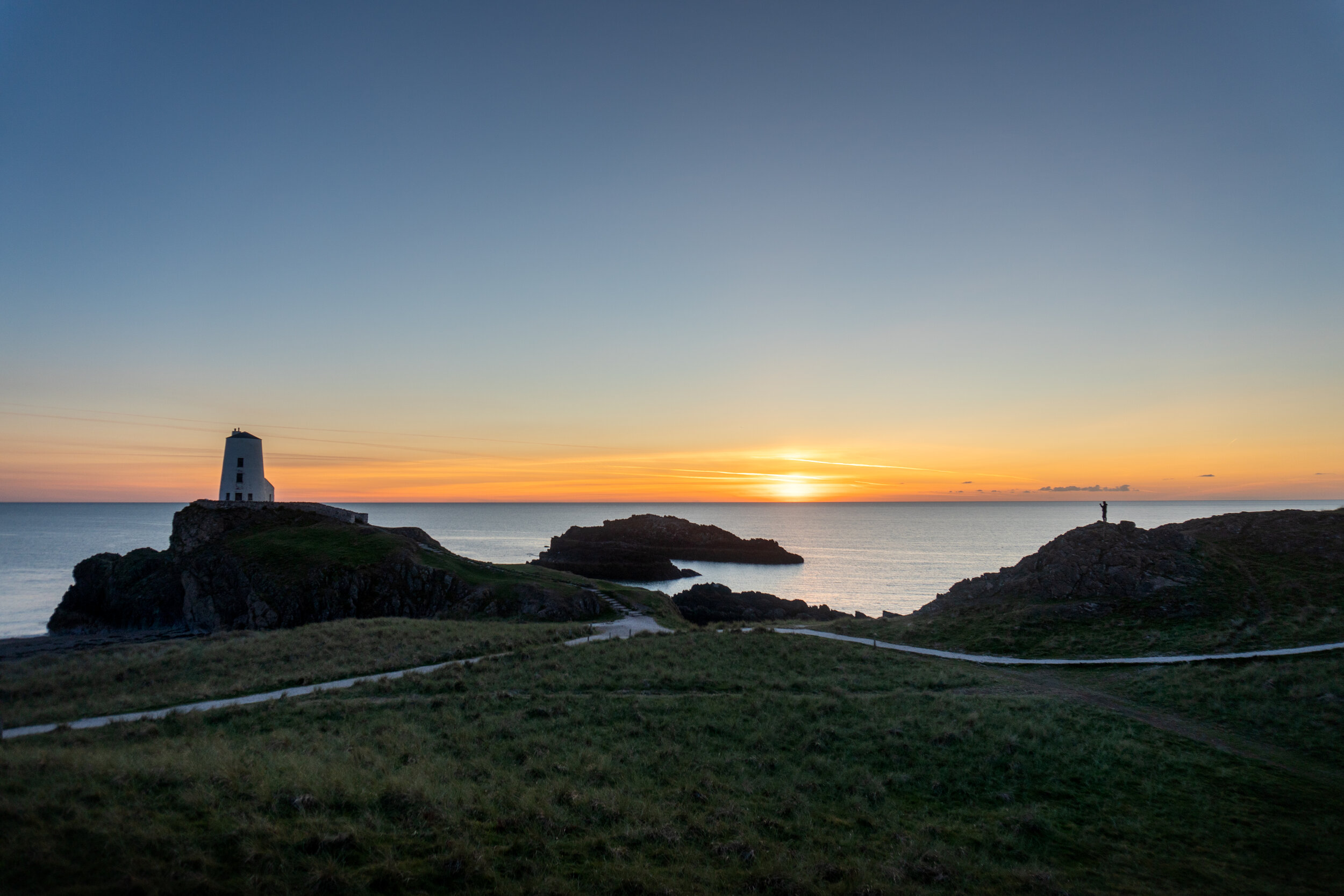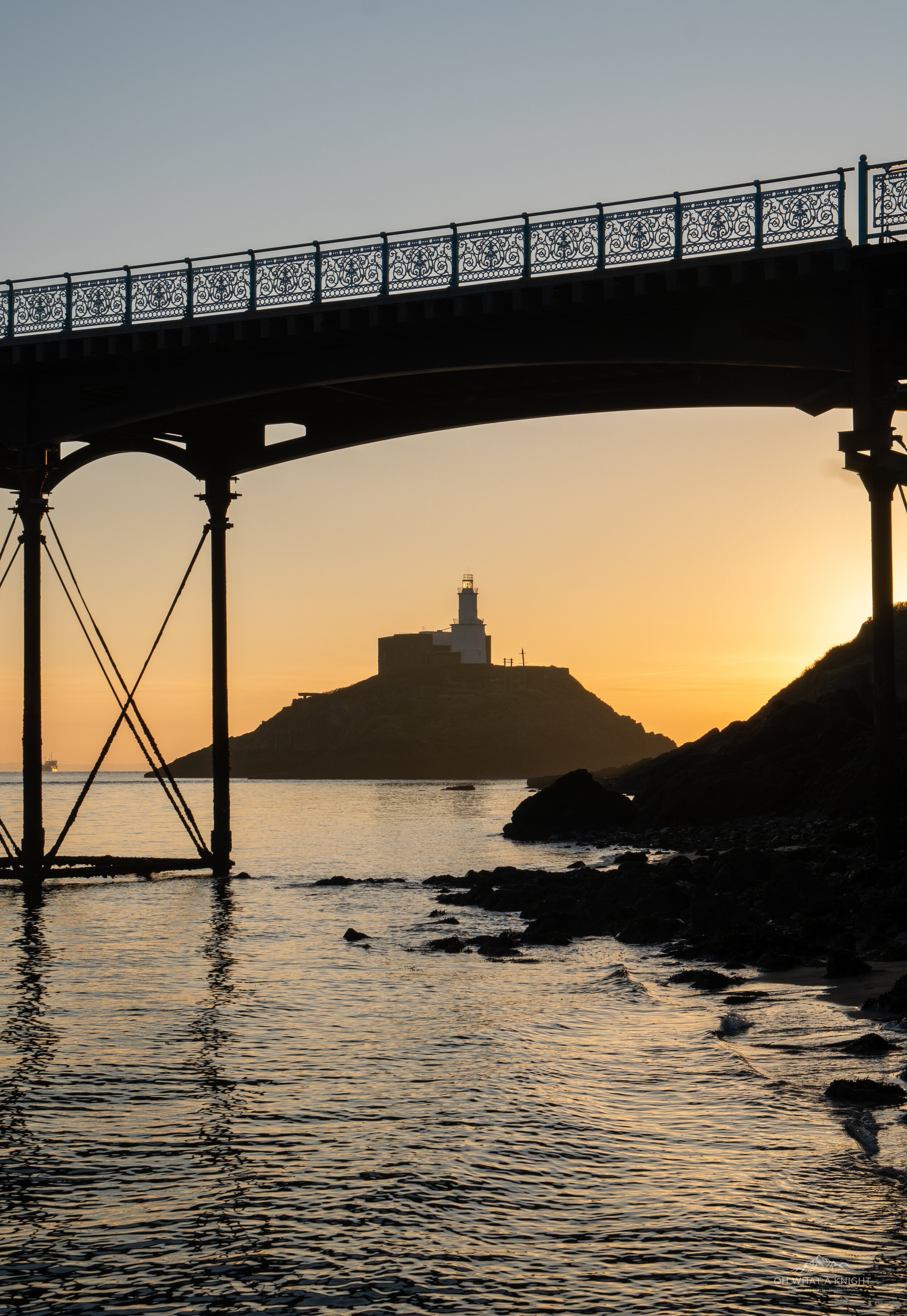9 must visit Lighthouses in Wales
Winter waves batter the breakwater of Porthcawl lighthouse
Surrounded by water on three sides, Wales is home to arguably some of the most dramatically beautiful coastline in the world. That coastal beauty is a double edged sword, with hidden rocky coves and magnificent coastal features becoming perilous coastal hazards for those at the mercy of the winds and tide.
Because of the treachery brought about by the Welsh coastline, it was essential that the final stages of a sailors journey were made to be as safe and as navigable as possible.
Between 1717 and 1970, 36 beacons of light were built along Wales' rugged coast. Many stand in magnificent locations towering high above the coastline it protects ships from. Of the 36 built, 27 are still active today and all but a handful are accessible to the public.
In the blog post below I list nine of my favourites which are worthy of a visit.
Twr Mawr, Anglesey
Best for - Relaxing & coastal scenery
Tŵr Mawr lighthouse, which means "great tower" in Welsh, is situated on the tidal island of Ynys Llanddwyn on the west coast of Anglesey.
The 10m (33ft) lighthouse was built back in in 1845 in a style characteristic of Anglesey windmills and marks the western entrance to the Menai Strait. Despite being decommissioned in 1975, the lighthouse still remains and has become an iconic location for photographers visiting North Wales.
In my opinion, Twr Mawr’s idyllic location and magnificent mountainous backdrop make it the most impressive Lighthouse in Wales. Alongside the lighthouse, Ynys Llandwyn is home to several golden sanded coves which give you an incredible vistas towards the mountain ranges of Snowdonia and the Llyn Peninsula.
This little outcrop of land is also rich in Welsh history, being home to the church of St Dwynwen, the Welsh patron saint of lovers.
How to reach the Lighthouse
To reach the lighthouse you have to walk through the wonderful Newborough Warren and Ynys Llanddwyn, which were declared as Wales’ first coastal National Nature Reserve back 1955.
The closest car park is located behind Newborough beach, postcode LL61 6SG. To reach it you first have to pass through a toll barrier then drive a mile through Newborough forest. You pay upon exiting the toll barrier and are charged for the length of time you park. its costs £2 for the first 2 hours then 40p for every additional 20 minutes. The maximum fee is £7 per 24 hours.
From the car park, the walk to the tip of Llanddwyn Island should take around 30-45 minutes via the shoreline. Make sure to check the tide times before you set off as the island gets cut off either side of high tide. If you do get stuck you will have to wade back through waist deep water. The tide time are available here;
I would recommend heading down in the late afternoon or early evening, taking the time to fully explore and enjoy the forest and island before staying for hopefully a memorable sunset.
South Stack, Anglesey
Best for - Birds & dramatic coastal views
Another gem on the Island of Anglesey which is well worth a visit.
The 28m (90 ft) South Stack lighthouse is located on a tiny islet just off Holy Island on the North West tip of Anglesey. Built in 1807, it has ben used for over two centuries as a warning beacon for ships crossing the Irish sea of the treacherous rocks beneath it.
The lighthouse building is open seasonally to the public and can be reached by firstly descending a rather steep 400 steps and then crossing a 30m steel footbridge which links the islet from the mainland. Access to the lighthouse costs £5.80 and once inside you are able to visit the engine room and exhibition area alongside being able to climb up the spiral staircase to the top of the lighthouse.
Even if you don’t plan on going inside the lighthouse, the location is well worth a visit just to witness the breath-taking coastal views from the surrounding sea cliffs.
Those towering granite cliffs which the lighthouse steer ships away from, act as a major nesting ground for sea birds. During certain times of the year there is a chance to see gulls, choughs, fulmars, peregrine falcons, guillemots, puffins and razorbills. There is even a designated RSPB visitor and information centre on the neighbouring cliffs which includes a café, picnic area, toilets, a viewing ‘tower’ with telescopes and binoculars. The centre is open daily from 10am-5pm from Easter until September.
There is limited free parking (8-10 cars) shortly before the lighthouse steps. There is additional parking several hundred meters back down the road at the RSPB visitor centre.
Whiteford, Gower Peninsula
Best for - Escaping the crowds
A mirrored image of Whiteford lighthouse from the rock pools beneath it.
Situated on the north western tip of the Gower, Whiteford lighthouse is a true gem of the peninsula and makes for a fantastic days walk, especially if you want to immerse yourself in coastal beauty and escape the crowds
Built back in 1865, the 13m tall decommissioned structure is the only wave-swept, cast-iron lighthouse left in Britain. The base of the lighthouse can be reached by a beautiful three mile mile walk across Whiteford sands. Although the majority of the walk is flat and along a sandy shoreline, the final 500m requires you to walk over some unstable and slippery rocks so some appropriate footwear is required.
As the lighthouse sits out in the treacherous Loughor estuary, which has the second largest tidal range in the world, its base is only accessible around 90 minutes either side of low tide.
If planning a trip, make sure you check the tide times and give yourself plenty of time to reach the dilapidated structure. Once you have visited the lighthouse take the time to walk back through or around the wonderful Whiteford nature reserve. The SSSI is home to an extensive salt marsh and dune system which is haven for both birds and animals (You’ll often see horses grazing on the reserve). I have a designated blog post and vlog outlining the walk which can be found below.
A drone shot of Whiteford lighthouse
Trwyn Du, Anglesey
Best for - Bioluminescent Plankton
Trwyn Du Lighthouse, aka Penmon Lighthouse, is situated on the eastern tip of the Island of Anglesey.
Constructed in 1838, the 29m (95ft) fully automated lighthouse is solar powered and marks the passage between Penmon point and Puffin Island (Ynys Seiriol).
The shoreline around the point is very popular with fishermen and those hoping to spot sea-life, with regular seal and porpoise sightings. However the major draw of this location is the possibility of laying eyes upon the magical Bioluminescent plankton. Bioluminescence, comes from “bio,” meaning life, and “lumin,” meaning light, and describes the light that some living creatures emit from their cells. This type of plankton emit an electric blue colour when disturbed or moved, such as during a breaking wave or a splash in the water.
Unfortunately the plankton is very rare and only occurs under certain conditions, with the optimum time being the calmer summer months after spells of very warm weather. Even if the conditions are right, it doesn’t guarantee a sighting. You often hear tales of photographers spending nearly two weeks waiting for the plankton which sometimes never shows. The best way to keep tabs on it is with the designated Facebook groups which list sightings in Wales
When the plankton has been spotted here, expect the shoreline to become busier than your local supermarket as people will flock here from all corners of the UK to capture the majestical phenomenon.
A large car park is available on thee shoreline of Penmon Point which can be accessed via a toll road costing £3. For those not wanting to pay, free parking is situated around one mile from the point. There’s is also a café and toilets close to the shoreline. The lighthouse can be seen from the car park.
Sunset at Trwyn Du lighthouse
Mumbles lighthouse, Gower Peninsula
Best for - A drink or bite to eat
A drone shot of sunset behind Mumbles lighthouse
Fun Fact, the village of Mumbles, derives from the French word mamelles, meaning 'breasts' and originally refers only to the two islands which are situated off the headland, one of which houses mumbles lighthouse.
Completed in 1794, the 17m solar powered structure is n iconic part of the village and is clearly visible from any point along the five mile stretch of Swansea bay.
A great sunrise location, there are several places to view and photograph it from, including the neighbouring mumbles pier, the headland above it, or the adjacent Bracelet bay.
For the adventurous amongst you, It is possible to reach this standing sentinel at low tide via a rocky scramble. Don't linger for too long as you will get cut off by the incoming tide and you'll either have a 10 hour wait or will have to make one embarrassing phone-call to the RNLI.
How to reach the lighthouse
There is free parking next to the Big Apple in the car park on the headland. If that is full there’s pay and display parking at both Mumbles pier or Bracelet bay .
For those wanting to stretch the legs or walk off the ice cream consider wither parking in the village of Mumbles and walking to the pier via the promenade. Alternatively you can walking the coast path around to the Langland bay taking in the wonderful coastal views in the process.
Mumbles lighthouse from above bracelet bay
Point of Ayr lighthouse, Flintshire
Best for - Ghostly sightings
Emerging from the sands of a sea battered headland of the most northerly point of mainland wales is is the he Point of Ayr Lighthouse, also known as the Talacre Lighthouse. The 18m (59ft) building, was built back in 1776 to guide the ships entering the Dee estuary however has been out of service since 1844.
Its isolated location, out on the sands of Talacre beach, sees it regularly take the brunt of any major storms. The constant ocean battering has only served to give the lighthouse a rather weathered look, further adding to its charm.
The lighthouse also has an apparent history of paranormal activity, with reported sightings of a man dressed in old-fashioned clothes on the top of the balcony. A paranormal team were brought in to investigate the lighthouse and apparently made contact with the ghost, who was the last living lighthouse keeper called Raymond. In 2009, a seven foot stainless steel ‘lighthouse keeper’ sculpture was built on the balcony as an ode to those ghostly sightings.
A great spot for watching the sunset, the base of lighthouse is accessible at low tide by taking a walk across Talcre beach from the pay and display car park.
Talacre lighthouse At sunset
Porthcawl lighthouse
Best for - Stormy weather
Built in 1866, Porthcawl Lighthouse is a 30ft hexagonal cast-iron lighthouse built out on the breakwater at Porthcawl point. It was the last coal and gas-powered lighthouse in the UK before it became electrified in 1997, and has kept south Wales shipping lanes safe through two world wars.
While the size and location of the lighthouse is far from memorable, it has become renowned worldwide for its wave battered images.
Anytime there’s a major storm in the UK you can almost guarantee that there will be a sea of photographers lining the shores of the promenade all trying to capture an iconic shot .Even if you aren’t into your photography the rough seas smashing into the breakwater and towering over the lighthouse make for an incredible sight.
The nearest pay and display car park is Hillsboro Place Carpark, however if you didn’t want to pay there are plenty of free parking spots dotted around the streets of Porthcawl.
Porthcawl lighthouse under assault from the forces of nature
Strumble, Pembrokeshire
Best for - Sealife
Strumble Head Lighthouse stands on Ynys Meicl (St. Michael's Island), a small rocky outcrop of land on the north coast of Pembrokeshire, five miles west of the town of Fishguard.
Built in 1908 to help guide the sea traffic between Ireland and Fishguard Harbour, the 17m tall structure is grade 2 listed building which became fully automated in 1980.
Unfortunately the lighthouse is separated from the mainland by an iron bridge which isn’t open to the public. However the surrounding coastal landscape is well worth stretching your legs upon as there’s a good chance you might spot seals, dolphins or porpoises. The lighthouses north westerly facing direction also makes it a great spot to watch the sunset from.
If you’re heading here on a weekend prepare to do some reversing as the lighthouse is situated at the end of a narrow single track lane. There’s two car free parks in front of the lighthouse with the second one actually being closer.
Sunset at Strumble
Nash Point, Glamorgan heritage coast
Best for: Exploring the Welsh coastal path
With its dramatic costal cliffs, secluded coves, and awe inspiring views the 14 miles of the Glamorgan Heritage Coast is a must visit for coastal ramblers and seaside lovers alike.
Situated just outside the village of St Donats, Nash point is a large bedrock beach, lined with fossils and rock pools, and backed by sheer 30m high rugged cliffs. The dramatic shoreline can either be seen from the coastal path which hugs the clifftop above, or explored from the rocks below which are accessible for several hours either side of low tide.
Adding to the locations charm is a 19th century, grade 2 listed lighthouse which still guards passing seafarers from the treacherous rocks below. Tours of the lighthouse are available but only by prior arrangement only.
Parking is available for around 8-10 in free gravel parking area however if that is full you can park for £3 at the cliff top cafe. From both locations you have to walk less than 50m in order to access either the cliffs or the beach below.
There we have it, the 9 must visit lighthouses in Wales. One thing I would say and which is evident from some of the images in this blog, is that all of these locations make a great places to either watch the sunset or the sunrise.
Did you find the blog useful ? Let me know your thoughts in the comments below.
If you did find it helpful, I’d appreciate you giving it a share or giving me a follow on social media, every bit of support goes a long way.
For more travel, & photography inspiration around Wales check out my in-depth guides to each of my favourite regions below.



















